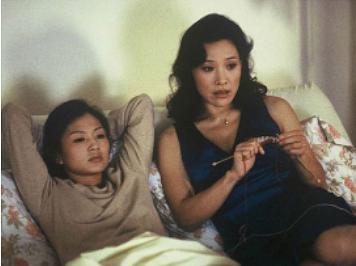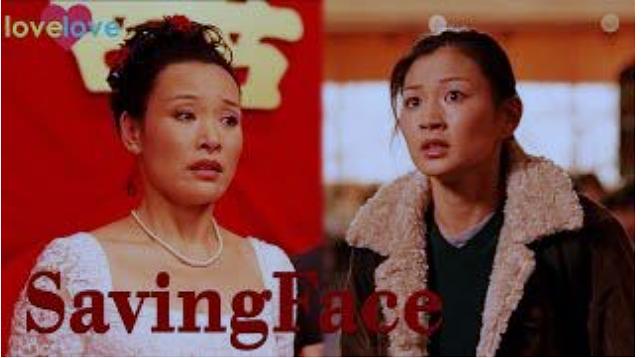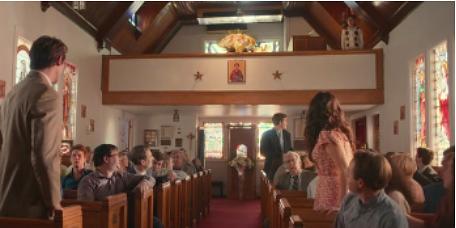Saving Face: Bold but not enough
When we are bombarded with blockbusters like Crazy Rich Asian which is acclaimed to be one of the first and sole silver-screen representations of Asian Americans, an independent film that pioneered the field of Asian American film –Saving Face- is obscured from public view. Saving Face is released in 2004 and directed by Chinese American director Alice Wu (who is recently known for the film The Half of It). It is a queer rom-com that tells the parallel romantic stories of the daughter Wil and her pregnant mother Hwei-Lan.
Saving Face is boundary-breaking and bold in terms of challenging established tropes of Asian American narratives. In Show/down time: “Race”; gender, sexuality, and popular culture, Nakayama sharply points out that in U.S popular culture, Asian American representation is often constructed as the Other to a center of white heterosexual masculinity. (Nakayama) Nevertheless, in Saving Face, the position of white heterosexual masculinity is challenged not only by its realistic depiction of China town life in New York but also by the bold narration of queer relationships. Two kinds of queerness are performed in Saving Face: First is the sneaky and cute lesbian love between Wil and Vivian; Second (which is usually ignored) is Hwei-Lan- a 48 years old widowed mom- ’s secrete relationship and pregnancy with Xiaoyu who was one generation younger than her. Alice Wu cleverly weaves these two stories together with the concept of “saving face” – an obsession in Chinese culture with an ethical reputation of the family- that renders both Wil and her mother unable to openly express their queerness (both of their affairs would be seen as a disgrace by the rigorous grandfather). Although the cultural clash between traditional Chinese values and American individualism is thematized in this film, unlike the conventional narrative of irreconcilable intergenerational conflict, the cultural struggle in Saving Face is rather internal to the character, and it is communication and mutual support between the mother and daughter that reconcile their internal ambivalence. The scenes where Wil and her mother huddled on the sofa watching soap operas together and conversing about their life elevates their bond: Wil comes out to her mother with “Ma, I love you. And I ‘m gay”; and Hwei-Lan also confesses her fear of motherhood and admitted to Wil that “You were different. You sprung from the womb already grown up.” It is the heart-to-heart conversations that characterize both women beyond their role of “mother” and “daughter” and evolve their relationship beyond the archetype of “second generation conflict theory”. (T. Nguyen)

However, this film disappoints me for succumbing to genre legibility – media are expected to follow the established rules of a particular genre. (Feng)Abruptly in the ending, the previously acrid and conservative-thinking Chinatown neighbors and the grandfather magically accept and welcome the mother and daughter to the party. This cliché and saccharine rom-com convention of a happy ending somehow undermine the boldness of this film, drawing it back to this pro-assimilation trope by saying that once they discard these ' restrictive traditions ' and adopt a more liberal mindset (that is more accepted by the American mainstream), they will be happier. I think it is better to end with an open ending at the bus scene allowing audiences to imagine the repercussions of their bold action rather than give a clear-cut answer that conspicuously fawns on the “coming-out” politics of queer liberalism. It overlooks the structural obstacles faced by the LGBTQ+ community as well as individuals’ bodily autonomy.

Although Alice Wu makes the concession to genre legibility, overall Saving Face is still an important representation that boldly tears down the stereotypical archetype of Asian Americans in film. Maybe that is why Saving Face is only popular in a cult way within the queer community while not legible in the mainstream markets that were still penetrated by white heterosexual masculinity.
Sidenotes: I watched Alice Wong’s 2020 film the Half of It before watching Saving Face – it was a frustrating realization to me that some scenes in The Half of It are exact replicates of Saving Face. For instance, Wil’s interruption of her mom’s unwilling wedding is repeated in The Half of It with Ellie Chu stopping Trig’s proposal to Aster. It seems to me that conventions of rom-com did restrict innovation and creativity in the narrative. At least is the case with Alice Wu.

Works Cited
Feng, Peter X. “Asian American Media Studies and the Problem of Legibility.” Cinema Journal, vol. 56, no. 3, 2017, pp. 125–30, https://doi.org/10.1353/cj.2017.0027.
Nakayama, Thomas K. “Show/down Time: ‘Race,’; Gender, Sexuality, and Popular Culture.” Critical Studies in Mass Communication, vol. 11, no. 2, June 1994, pp. 162–79, https://doi.org/10.1080/15295039409366893.
Nguyen, Terry. “Saving Face Is a Delightful Queer Rom-Com — and a Love Letter to Asian Moms.” Vox, 4 May 2022, www.vox.com/23055086/saving-face-alice-wu-romcom-asian-moms.
